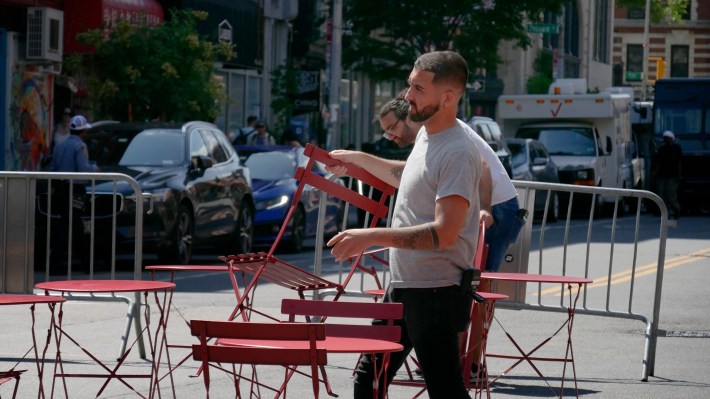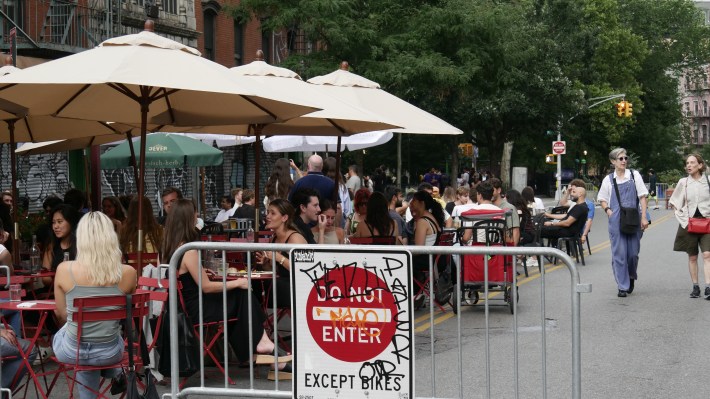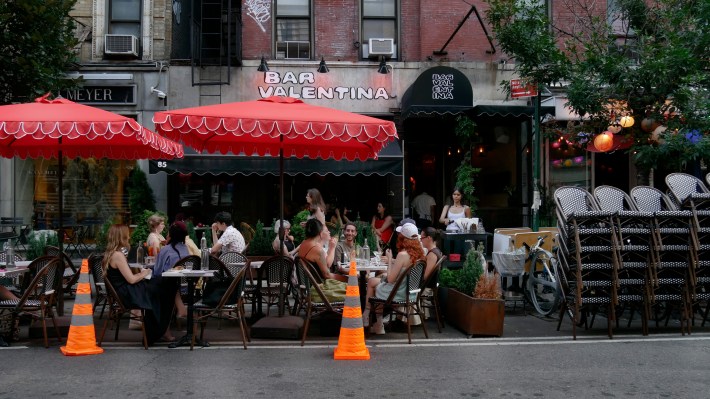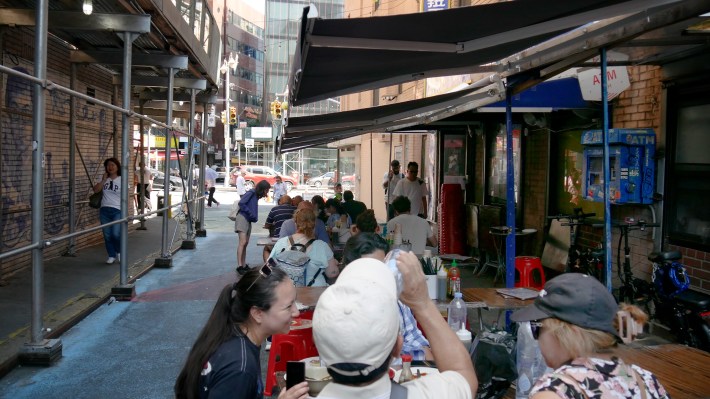Gov. Hochul not only killed a revenue source for the MTA when she canceled congestion pricing — she also squandered the expansion of business-friendly, car-free streets that could have been achieved once more than 100,000 cars were banished from Lower Manhattan every day.
The “Gridlock” governor claimed she was thinking of "the little guys" — local businesses and alleged diner patrons who didn't want to pay the $15 toll. But she forgot about the other "little guys": Restaurateurs, bar owners and neighborhood residents who are providing proof that when cities prioritize pedestrians and create spaces that don't cater to the automobile, businesses thrive and communities get empowered.
“[Limiting car access] is not hurting businesses, in any sense,” said Vincent Aloi, the manager of Le Dive, a popular wine bar and eatery located on Canal Street, whose eastern end is closed to car traffic every day, allowing multiple restaurants to set up shop in the street. “It's getting people to be more out and about, enjoying the neighborhood. People come here because they know that there are so many businesses surrounding the street closure, and they're able to provide their patronage to every single one of them.”

Businesses on the Canal, Orchard and Broome open streets on the Lower East Side have been able to turn low-capacity bars into sprawling outdoor watering holes, making the rare outdoor drinking and dining opportunities a tourist attraction. Aloi said Le Dive triples its business in the warmer months.
But it's not just the outdoor seats that are making business boom, it’s the community feel that comes with cutting cars out of the area.
“Having more open street space and opening the roadways for more bikes just improves the quality of life of the neighborhood,” Aloi told Streetsblog. “People are able to utilize this space as their backyards and connect with one another and be more social.”
Patrons of restaurants like Le Dive, Dimes and Cervo's can relax like they are in Paris because the city closed Canal Street from Essex to Orchard to car traffic from 3 p.m. to 11 p.m. every day as a part of the 2020 pandemic-era open streets program that is now permanent.
Congestion Pricing, which was set to begin June 30, would've removed 153,000 cars every day from the central business district — or 1.78 cars per second. The governor claims she made the decision to halt the tolling scheme to help local business owners, but the open streets program throughout the city proves that prioritizing pedestrians and cyclists is better for businesses.

Take the open street section of Canal Street, which has been transformed into an economic hub because the previously packed bars and restaurants can accommodate more people and hire more staff.
"Without the open street, I wouldn't even have a job," Dick Wagner, a server at Clandestino, a bar on Canal, told Streetsblog. "There is no need to have a server inside the bar. Now, there are five or six dedicated staff just to serve the outdoor tables."
Wagner, a native New Yorker from Glendale, Queens, said the city should expanding efforts to prioritize people over cars.
"This is something I've wanted for a long time," Wagner said.

The Lower East Side’s other open streets, at Broome and Orchard, are just a couple of blocks away, creating a network that encourages commerce in the entire Lower East Side area; the “Orchard T” includes Orchard and Broome streets between Delancey Street and Grand Street, and operates daily from noon to 10 p.m.
"[The open streets program] creates a pedestrianized destination that supports commerce and community at the same time," said Tim Laughlin, president of Lower East Side Partnership.
The partnership operates the "Orchard T" area which closes Orchard Street between Delancy and Grand as well as Broome between Allen and Ludlow everyday from noon to 10 p.m. as well as the "Orchard Historic" open street which spans Orchard Street between Delancey and Houston Streets, and operates on Sundays from 8 a.m. to 6 p.m.

“Open Streets has helped create a diverse community where anyone can just relax and enjoy their food without worrying about cars coming around every corner,” said Kenna Crogey, a server at Dudley’s, a popular restaurant on Orchard Street.
Nearby in Chinatown, the permanent pedestrian plaza at Doyers Street was so successful that local business leaders asked the city to create an open street around the corner on Pell Street, which operates on weekends.
“People saw how successful Doyers Street was and [local businesses] actually petitioned the DOT to let them try an Open Street,” said Wellington Chen, the executive director of the Chinatown Partnership.
The success of the businesses on Doyers has been astronomical. Tasty Hand Pulled Noodles, a hole in the wall that used to have a less than 10-person capacity, now fills into the roadway. The huge increase in revenue they earned from the increased foot traffic and seating has allowed them to open two other restaurants, growing their small business, according to Chen.

The city’s own data backs up the success. The city analyzed five open street corridors to figure out how well the program helped businesses recover from the pandemic, the report found that sales growth at restaurants and bars on Open Streets outpaced sales growth on an average street in the same borough.
“The report proves what we have all seen with our own eyes for two years: New Yorkers not only love dining outdoors, when given the choice, they prefer to spend their time and money along car-free Open Streets,” DOT Commissioner Ydanis Rodriguez said in the report.
Even with this clear success in Lower Manhattan, New Yorkers are still suffering through congestion because state and local leaders continue to perpetuate the myth that cars equal good business, when the opposite is true.
“The majority [of people visiting] come from transit, walking or biking. Because, as we know, about 76 percent of Manhattan households do not own a car. This area is not renowned for its plentiful parking, so if you’re a visitor, you want to be flexible and therefore you don't need a car,” Chen added.
On the Lower East Side and in Chinatown, the pre-grid layout and narrow streets create an optimal space for pedestrianization without much intervention. But in other Manhattan areas it isn't so clear cut. It took a once-in-a-lifetime global pandemic for the city to create the open streets program. Congestion pricing would have made future pedestrian and cyclist centered projects more feasible in other parts of Manhattan because of the predicted decrease in car volume in the congestion zone.
It has now been almost a month since the governor hit the breaks on the program, and with that a potential new era in street redesign.






